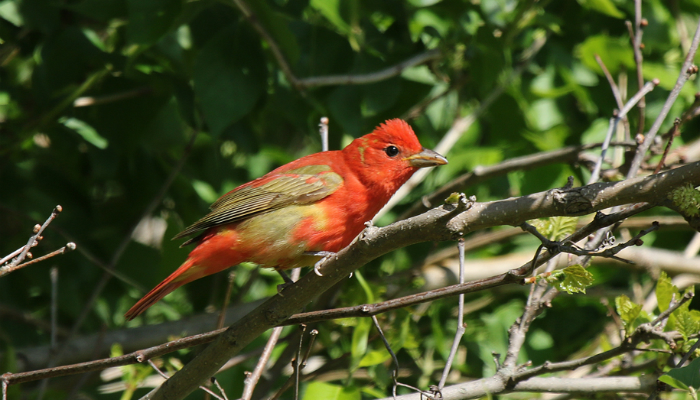Deep Woods Conservation Promotes Bird Diversity

Summer Tanager photo courtesy of Carl Kurtz
I’ve always been an avid birder, carving out time to travel throughout the country and the world on birding expeditions. But recently I was excited to do some serious birding right here in the county on Bur Oak Land Trust’s Big Grove Preserve. Taken together with the recent acquisition of an additional forty acres (Big Grove Addition), this area is a large, deep-woods habitat ideal for North American migratory birds as well as species that prefer to nest in this type of forest.
The peak season for bird migration in Iowa is May, but I began regular visits to the preserve in mid-April. Yellow-bellied Sapsuckers and Brown Creepers were abundant then. In May, several local birders turned out to assist me in the effort to document the birds of Big Grove. Bur Oak Land Trust members Linda Rudolph and Bill Scheible as well as local birders James Huntington and Chris Edwards all lent a hand. Birders went out to the preserve on an almost daily basis during the month. What we found was heartening. We documented 95 species, including 19 species of wood warblers. Summer residents include Scarlet Tanager, Kentucky Warbler, Wood Thrush, Veery, Acadian Flycatcher, and Pileated Woodpecker. Blue-winged Warblers had at least three nesting territories. We also found a nest of Cooper’s Hawks, but the most unusual and exciting find was a pair of Summer Tanagers!
One of the most important aspects of this exciting effort is that deep-woods habitat uninterrupted by roads or other human intrusion has become increasingly uncommon in Iowa. The presence of this diverse group of birds at the preserve shows how attractive the qualities of this deep-woods habitat are – both for spring migrants and for summer residents. To encourage diversity, conservation efforts of places like Big Grove and the Big Grove Addition are vital.


